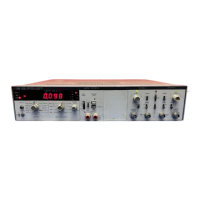Model 5328A
Operation
START
n
I
I
STOP
I
I
I
I
I
I
Figure
3-4.
Clock Pulses
NOTE
in a time iiitervai' measurement,
C/O&
puises dre
accumulated for the duration the main gate
is
open.
The gate
is
opened
by
one event, START and closed
by
the other, STOP.
3-24. Resolution
3-25. The resolution of the measurement
is
determined by the frequency of the counted clock
(e.g., a 10MHz clock provides 100 nsec resolution). Clearly, the elements within the time interval
counter (input amplifier, main gate, DCA's) must operate at speeds consistent with the clock
frequency, for otherwise the instrument's resolution would be meaningless. The standard
Universal Module of the 5328A countsa 10MHz clock.The Option 040Universal Modulecounts a
100 MHz clock to give
10 ns single-shot resolution.
3-26.
Clock frequencies of 1, 10, 100 MHz, etc., are preferred since the accumulated count,
with the appropriate placement of decimal point, gives a direct readout of the time interval. This
explains why the conventional time interval counter
is
at present limited to 10 nsec, a clock
frequency of 100 MHz. 1 GHz is beyond reach and a clock frequency of 200 MHz would require
some arithmetic processing of the accumulated count in the DCA's to enable time to bedisplayed
directly.
3-27. Time Interval Averaging
3-28.
This technique is based on the fact that
if
the
?I
count error is truly random it can be
reduced by averaging a number of measurements. The words "truly rand0m"aresignificant. For
time interval averaging to work the time interval must
(1)
be repetitive and
(2)
have a repetition
frequency which
is
asynchronous to the instrument's clock. Under these conditions the
resolution of the measurement is:
&I count
JFi
where
N
=
number of time intervals averaged.
3-29.
With averaging, resolution of a time interval measurement is limited only by the noise
inherent in the instrument. Ten picoseconds resolution can be obtained with the
5328A. This is
not the whole story, however, since most time interval averaging suffers one severe limitation;
namely, the minimum measurable time interval
is
limited to the period of the clock. This
limitation
is
removed by circuits known as synchronizers which are employed in the 5328A to
measure intervals as small as 100 ps.
Artisan Technology Group - Quality Instrumentation ... Guaranteed | (888) 88-SOURCE | www.artisantg.com

